Music vocabulary is a key component of many standards we teach in music education. This can seem like a very boring and dry concept to teach, but let me beg to differ. Teaching music vocabulary is one of my favorite things to teach! Let me share with you some of my favorite ways to have students experience music vocabulary in ways they will never forget.
Teaching Music Vocabulary
Teaching music vocabulary doesn’t have to be boring. You can tie in movement, pretend play and music performance SO easily. The more ways that you find to incorporate music vocabulary into your lessons, the more practice students will have with the music vocabulary terms.
I love having students move to show musical concepts like form, dynamics and tempo. They can not only hear the concepts in action. They can actually feel the concepts in their body (yay kinesthetic learning!).
I also love coloring activities or listening worksheets that give students the chance to APPLY the new vocabulary. Or books and videos the show off the music vocabulary we are learning. The ways to teach music vocabulary are just endless.
Let’s take a look at some of my favorites!
Music Vocabulary Activities
Teaching Dynamics
Let’s start with dynamics. Usually I start by teaching forte and piano in first and second grade. Don’t forget that repetition is key when teaching vocabulary. You can do almost the same lessons in first and second grade and it will be a critical review. In third grade I like to teach crescendo and decrescendo. And then in fourth and fifth grade we talk about mezzo-forte, fortissimo, mezzo-piano and pianissimo.
Remember that you will have to look at your own music standards to know when exactly to teach each dynamic vocabulary words.
William Tell Overture
The William Tell Overture is one of my favorite pieces for introducing forte and piano. It has lots of energy, doesn’t take too long and allows me to easily show the contrasting dynamics.
I love to have students use yellow and blue cards (I made mine out of simple construction paper). If you wanted to be fancy you could write forte and piano on them, but I just write the words on my PowerPoint in the correct color. Then students move their cards along to the music with me. We hold up forte (yellow) during the loud sections and piano (blue) during the quiet sections.
You can watch the whole routine right here on my YouTube video to get the idea. This activity is a hit every year, and I always pull it up again in second grade as a quick way tot remember and review the vocab terms.
Celebrity Lullaby
This is another fun activity to show off loud and quiet. You could even use this in kindergarten when you are still introducing the ideas of loud and quiet.
Ricky Gervais is singing a lullaby to Elmo, but sometimes his lullaby gets a bit loud. The kids crack up about it, and it hammers home the idea of loud and quiet quite well. You could even have a discuss about purposes of different types of music and why a lullaby shouldn’t be loud.
No matter what, this one is worth a quick giggle with your younger students.
Ten Oni Drummers
Matthew Gollub is a great author for elementary music literature. Ten Oni Drummers is no exception. It is a Japanese counting book. Students get to learn about how to count to ten in Japanese, as well as taiko drums.
I read the book to the class. As each new oni enters, I increase my voice level, from whispering at one oni to shouting by ten oni. When we read the book again, the class chants a rhythmic pattern every time a new oni comes into the book. Again, we get louder and louder as the oni increase.
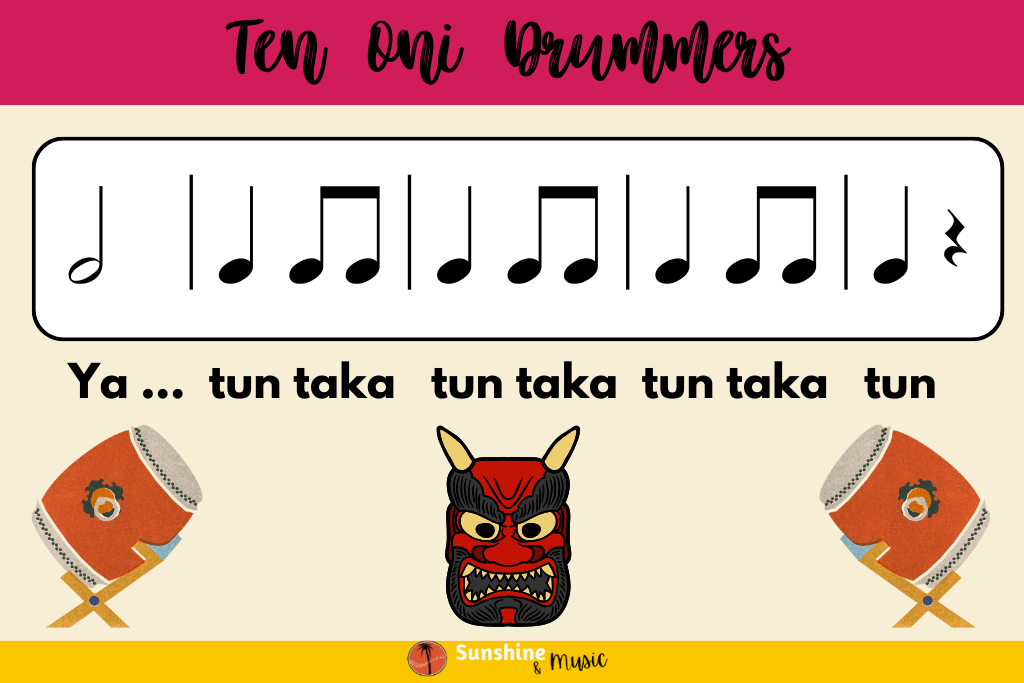
Finally, we add drums and do one final version! I like doing this book in second or third grade as preparation for talking about secondary dynamics (pp, mp, ff, mf).
Hall of the Mountain King
This is a piece I love to use for teaching what I like to call “secondary dynamics,” such as mezzo-piano or pianissimo. The song uses the exact same theme throughout most of the song, but with increasing speed and volume.
We follow along with the song using a listening map while doing a simple body percussion to match the melody. The music starts off pianissimo and then grow to fortissimo by the end. So of course, our body percussion gets louder and louder as well.
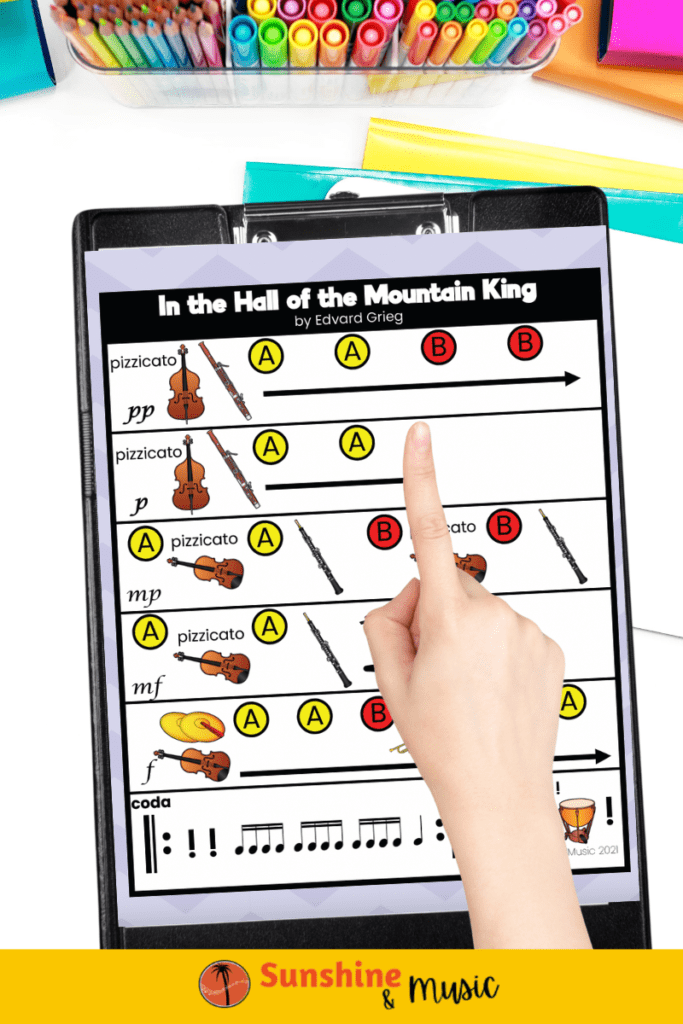
Then, I have them do a cup passing activity along with the song for a little extra fun!
Teaching Tempo
Teaching tempo is a great time to have students move to the music. There are plenty of songs with tempo changes, so take your pick. But here are a couple that I use year after year.
Fast and Slow Song (Rabbit and Turtle)
I love The Laurie Berkner Band and the fun songs they make for littles. The Fast and Slow Song is a fun way to get your younger students moving to show fast and slow tempo.
I like to have students watch the first time and I act out the song with two scarves – one for the fast rabbit and one for the slow turtle. I ask the students which animal was fast and which one was slow. Then they get to have two scarves and act the song out along with me.
Grand Old Duke of York
This song is one I use to teach my older grades about specific types of tempos. I usually teach largo, moderato, allegro and presto, but feel free to teach whichever ones you wish.
We start out doing the song at a normal speed. Students march to the march and have to reach up whenever I say up and down whenever I say down. Then we change it to different tempos and the challenge increases!
This one will help your students learn tempos while getting their heart rate up!
Practicing Music Vocabulary Terms
Don’t forget that just as important as learning music vocabulary terms is practicing that music vocabulary! Here are some quick, easy and fun ways to review vocabulary throughout the year.
Music Vocab Write the Room
I love a good Write the Room activity. You can tailor them to any concept you want to teach, including music vocabulary.
I put posters around the room with definitions of music vocabulary words. Students had to find the posters and write down the definitions. Then, they had to match each definition with the correct music vocabulary word.
Quick, easy, fun and effective vocab review!
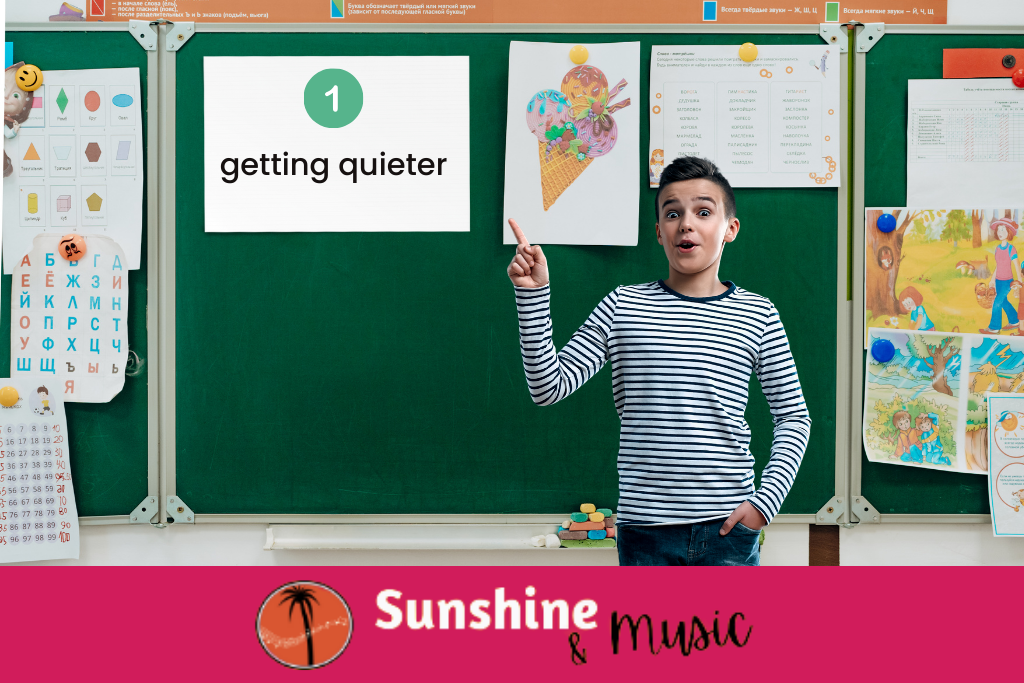
Find Someone Who
Another fun activity that allows your students to socialize is a Find Someone Who activity. I love to use these at the beginning of the year to review concepts that we learned last year. The basic idea is that you have to find someone who can … define the word forte, for example.
I set the worksheet up like a bingo grid, with about nine different tasks. You could even pepper in fun stuff like “Find someone who speak another language” or “Find someone who travelled somewhere this summer” to go along with your vocab and concept review.
It’s a great get to know you, classroom environment builder to do that slides in some vocab review.
Music Vocabulary Wall
Another great way to make sure your students keep important vocabulary front and center is to have a vocabulary word wall. Students will always have the vocabulary terms they need ready to reference!
I especially like to add iconic imagery to go along with the music terms because that helps students who cannot yet read the definition to still understand the concept.
This is the music vocabulary word wall that I use in my classroom.
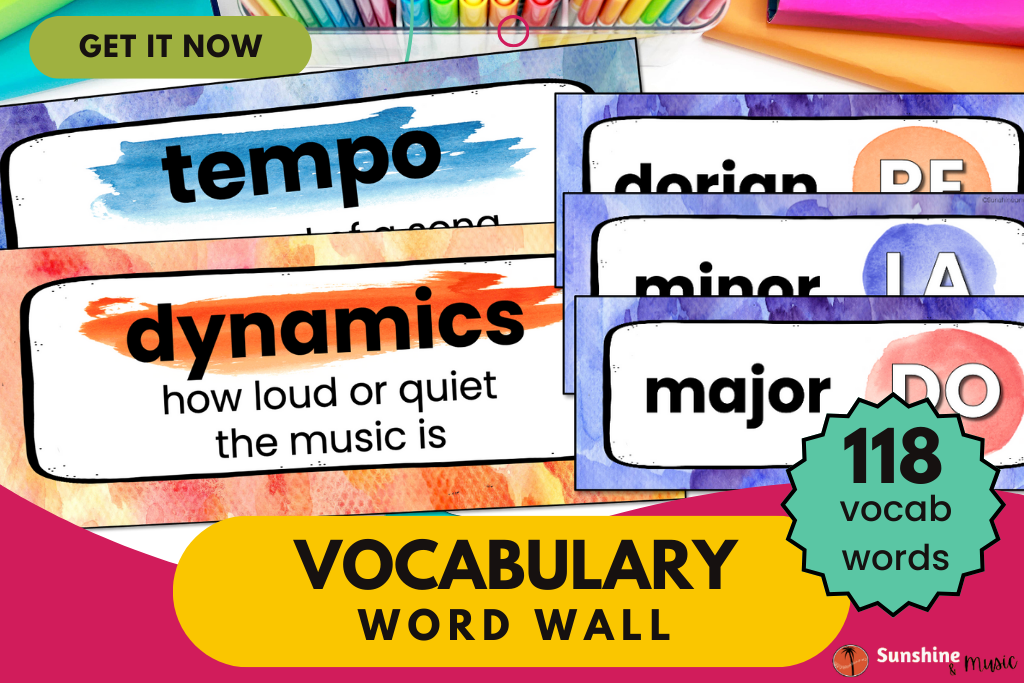
Using Music Vocabulary to Describe Music
Don’t forget to give your students the chance to APPLY their music vocab knowledge! This is where they really get a chance to show their understanding of the music terms they have learned. Plus, it is a higher depth of knowledge than just rote learning.
Listening Maps and Listening Glyphs
Using listening maps with questions is a great way to have students listen and analyze a piece of music using correct vocabulary. Listening maps make it easy to follow along with famous musical works. And then as they follow along, they can answer questions about what they are hearing.
You can learn more about using listening maps in my blog post: Listening Maps for Music: The Ultimate How To Guide.
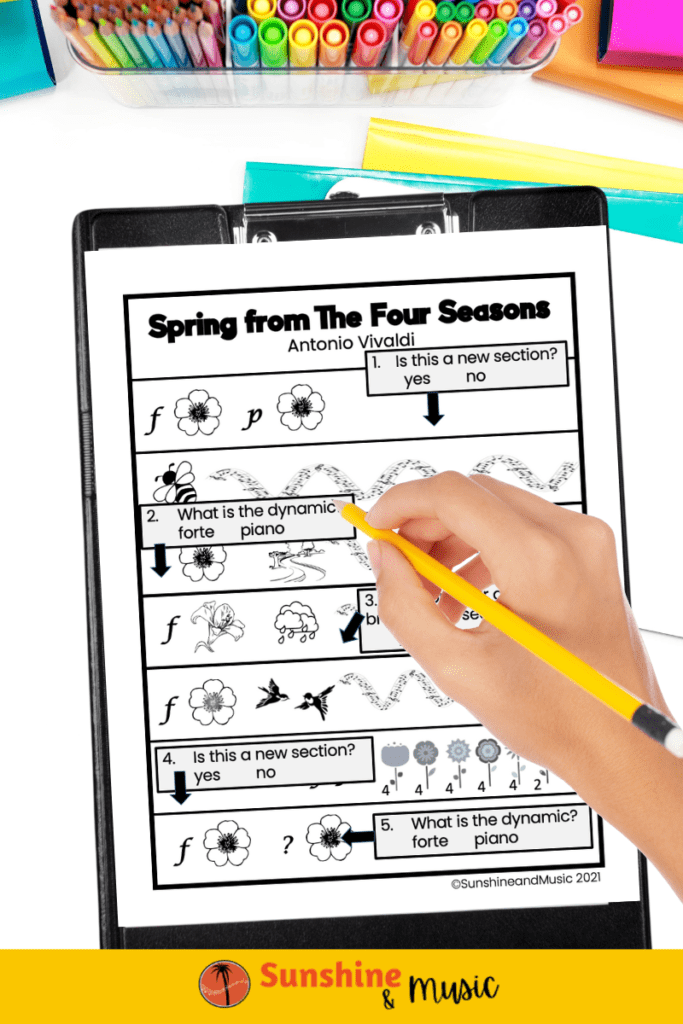
You can learn how to create your own listening map here. Or take a look at the pre-made listening maps I have available here and save yourself some valuable time! Almost all of my listening maps come with listening question worksheets as well.
Listening glyphs (basically guided listening coloring sheets) are another favorite of mine. Students color based on what they hear in the music. Was the beginning forte? Color the hat red. That kind of thing.
Again, you could create your own listening worksheets. Or if you want to see some of the ones I have available, take a look at this pre-made listening glyphs.
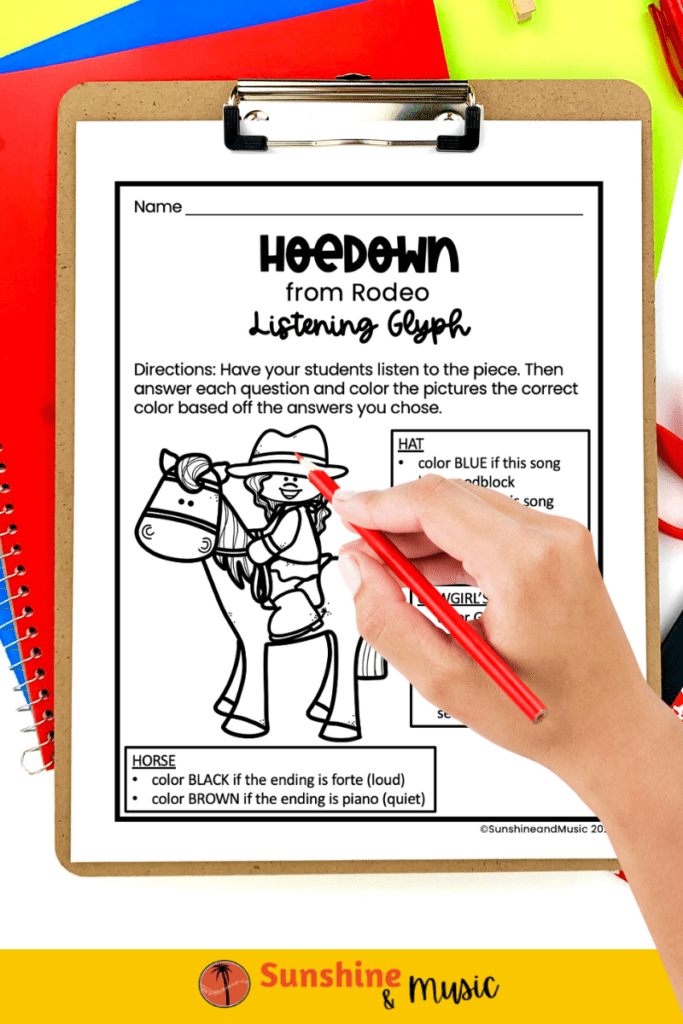
Close Read of a Song
Is your school into close reading? I know my previous school was ALL ABOUT this trend. And I actually bought in once I realized I could use musical works as a non-traditional text.
Basically, the idea is that you look through a text (or music piece) more than once and gain deeper and deeper understanding with each repetition.
You can read more details about how I have done close reads with music with my Close Reading in Music Class blog post.
Music Listening Sheet
Another great way to have your students listen and describe music is with some sort of guided listening worksheet.
I usually like to divide into a couple main sections. I might have dynamic terms for them to circle in one section, instrument families in another and a couple types of tempos in a third section. Students could listen and circle what they hear.
Then, we could have a class discussion about what they circled and why and come to some conclusions about the piece.
Music Terms List
These are some of the terms that I teach my students over the course of their time in elementary school. It is not an exhaustive list of all music terms, but it gets at the essential vocabulary for describing music.
Music Terms – Dynamics
Dynamics – the volume of the music
Pianissimo – very quiet
Piano – quiet
Mezzo-Piano – medium quiet
Mezzo-Forte – medium loud
Forte – Loud
Fortissimo – very loud
Crescendo – getting louder
Decrescendo – getting quieter
Music Terms – Tempo
Tempo – the speed of the music
Largo – slow
Moderato – medium speed
Allegro – fast
Presto – very fast
Music Terms – Instruments
Brass Family
- Trumpet
- Trombone
- Tuba
- French Horn
String Family
- Violin
- Violia
- String Bass
- Cello
- Harp
Woodwind Family
- Flute
- Piccolo
- Clarinet
- Saxophone
- Oboe
- Bassoon
Percussion
- Snare Drum
- Bass Drum
- Cymbals
- Triangle
- Maracas
- Xylophone
Keyboard
- Piano
- Organ
Music Terms – Melody and Rhythm
Rhythm – the length of the notes
Form – the order of events in a piece of music
Melody – the tune of the song
Pitch – how high or low a note sounds
Solo – one player
Duet – two players
Trio – three players
Quarter – four players
More Blog Posts For You …
Books for Music Class: How To Use Children’s Literature in Elementary Music







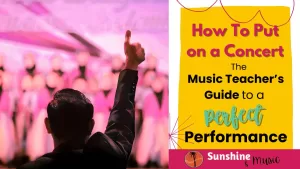
2 Responses